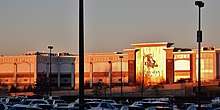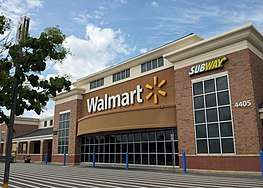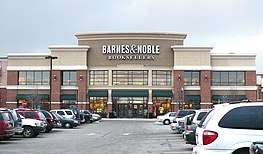Big-box store
A big-box store (also supercenter, superstore, or megastore) is a physically large retail establishment, usually part of a chain of stores. The term sometimes also refers, by extension, to the company that operates the store. The store may sell general dry goods, in which case it is a general merchandise retailer (however traditional department stores, as the predecessor format, are generally not classified as "big box"), or may be limited to a particular specialty (such establishments are often called "category killers") or may also sell groceries, in which case some countries (mostly in Europe) use the term hypermarket, whereas in the U.S. there is no specific term for the format, which both Target and Walmart offer in most branches.

Typical architectural characteristics include the following:
- Large, free-standing, cuboid, generally single-floor structure built on a concrete slab. The flat roof and ceiling trusses are generally made of steel, and the walls are concrete block clad in metal or masonry siding.
- The structure typically sits in the middle of a large, paved parking lot. It is meant to be accessed by vehicle, rather than by pedestrians.[1]
- Floor space several times greater than traditional retailers in the sector, providing for a large amount of merchandise; in North America, generally more than 50,000 square feet (4650 m2), sometimes approaching 200,000 square feet (18,600 m2), though varying by sector and market. In countries where rentable space is at a premium, such as the United Kingdom, the relevant numbers are smaller and stores are more likely to have two or more floors.
Big box stores are often clustered in shopping centers known as retail parks in the U.K. and, in the United States, when they range in size from 250,000 square feet (23,000 m2) to 600,000 square feet (56,000 m2), they are referred to as power centers.[2]
Commercially, big-box stores can be broken down into two categories: general merchandise (examples include Walmart, Kmart and Target), and specialty stores (such as Home Depot, Barnes & Noble, or Best Buy) which specialize in goods within a specific range, such as hardware, books, or consumer electronics respectively. In the late 20th and early 21st centuries, many traditional retailers—such as Tesco and Praktiker opened stores in the big-box-store format in an effort to compete with big-box chains, which are expanding internationally as their home markets reach maturity.[3]
Criticism
Labor
Big-box development has at times been opposed by labor unions because the employees of such stores are usually not unionized. Unions such as the United Food and Commercial Workers Local 770 and the Joint Labor Management Committee of the Retail Food Industry have expressed concern about the grocery market because stores such as Kmart, Target, and Walmart now sell groceries.[4] Unions and cities are attempting to use land-use ordinances to restrict these businesses.[5]
Urban planning

Because it is generally inaccessible to pedestrians and often can only be reached by motor vehicles, the big-box store has been criticized as unsustainable and a failure of urban planning.[6][7]
Big-box stores in various countries
Australia
The first company in Australia to use the big-box model was IKEA beginning operation in Australia in 1975. Bunnings Warehouse followed in 1995 and Mitre 10 Australia adopted the model with the "Mitre 10 Mega" stores first opening at Beenleigh, Queensland in 2004. Costco has since expanded across Australia since opening its first store in 2009.
Canada
Apart from major American big-box stores such as Walmart Canada and briefly now-defunct Target Canada, there are many retail chains operating exclusively in Canada. These include stores such as (followed after each slash by the owner) Hudson's Bay/Home Outfitters, Loblaws/Real Canadian Superstore, Rona, Winners/HomeSense, Canadian Tire/Mark's/Sport Chek, Shoppers Drug Mart, Chapters/Indigo Books and Music, Sobeys, and many others. The indigenous Loblaw Companies Limited has expanded and multiplied its Real Canadian Superstore (and Maxi & Cie in Quebec) branded outlets to try to fill any genuine big-box market and fend off the damaging competition that a large Walmart penetration would inflict on Canadian-based retailers.
In the early 21st century, commercial developers in Canada such as RioCan chose to build big-box stores (often grouped together in so-called "power centres") in lieu of traditional shopping malls. Examples include Deerfoot Meadows (Calgary), Stonegate Shopping Centre and Preston Crossing (Saskatoon), South Edmonton Common (Edmonton), and Heartland Town Centre (Mississauga).
There are currently more than 300 power centers, which usually contain multiple big-box stores, located throughout Canada.
China
Most large grocery stores in China are of the big box variety, selling big screen TVs, computers, mobile phones, bicycles, and clothing. Many foreign names appear, such as Carrefour, Auchan, Tesco, Lotte Mart, and Walmart, as well as dozens of Chinese chains. Most stores are three stories with moving sidewalk-style escalators. Some stores are so large as to have 60 checkout terminals and their own fleet of buses to bring customers to the store at no charge.
France
Many configurations exist: the hypermarket that sells many kinds of goods under one roof (like French chains Carrefour, Auchan, and E.Leclerc), most of which are integrated within a shopping mall; the supermarket that is a smaller version of a hypermarket; the market located in city centres; the department store, which first appeared in Paris, then opened in other parts of the world; the "category killer" superstore that mainly sells goods in a particular domain (automotive, electronics, home furniture, etc.); and the warehouse store.
Hong Kong
To contend against Carrefour, PARKnSHOP opened the first superstore in 1996 based on the concept of a wet market. Most superstores in Hong Kong emphasizes one-stop shopping, such as providing car park services. Today, PARKnSHOP has more than 50 superstores and megastores, making it the largest superstore network in Hong Kong. The first Wellcome superstore opened in 2000 and it has only 17 superstores. In addition, CRC has four superstores in Hong Kong.
However, because Hong Kong is a very densely populated city, the sizes of superstores are considerably smaller than those in other countries. Some superstores are running at deficit, such as Chelsea Heights which therefore has stopped selling fresh fish. Furthermore, some PARKnSHOP superstores and megastores, such as Fortress World, belong to the same corporation, Hutchison Whampoa.
India
India is going through a retail revolution since the late 1990s, following the introduction of Big Bazaar in 2001.
However, even before that, large retail stores were not uncommon in India. Spencer's, a popular hypermart, traces its history as far back as 1863. Likewise Saravana Stores operating as a large independent showroom format since 1969, continue to grow in a mammoth manner. Saravana Stores operating format is said to be the inspiration for Big Bazaar's Kishore Biyani.
Similarly, conglomerates, such as Raheja's, Future Group, Bharti, Godrej, Reliance, and TATA, have over the last decade ventured into large-format retail chains. However, most of the stores opened in large malls and not as independent big box format stores, even though small and medium enterprises (SMEs) still account for the majority of the daily consumer transaction needs. However, the most successful consumer retail chain that took the market and penetrated also to tier 2 and tier 3 cities was D Mart, owned by Avenue Supermarkets Limited.
An attempt was made to allow international large format retailers such as Walmart into the country. However, it was successfully opposed by small retailers citing job elimination due to increased efficiency and lowered prices due to fewer losses and lower costs.
India's true Big box format store was opened by IKEA in city of Hyderabad.
Republic of Ireland
In Ireland, large merchandise stores in the style of U.S. superstores were not a part of the retail sector until the late 20th century. Dunnes Stores have traditionally had a supermarket-plus-household-and-clothes model and now have some large stores. Tesco Ireland now runs upwards of 19 hypermarkets across the country.
New Zealand
The big-box phenomenon hit New Zealand in the late 1980s, with the introduction of Kmart Australia and later the "Warehouse" superstore, a local company. Mitre 10 New Zealand opened their first Mega in 2004 at Hastings, New Zealand six months before the Australian Mega store; it opened to great success with 20 more stores opening within two years. Australian-owned Bunnings Warehouse opened its first store in New Zealand in 2006.
United Kingdom
In the United Kingdom, Makro and Costco membership-only warehouse club stores have been around for 3 decades. General merchandise shops along the lines of U.S. superstores are not a large part of the retail sector, but this has been changing in recent years, with the creation of extra-large supermarkets such as Tesco and Asda selling a broader range of non-food goods, typically in out-of-town shopping centres or retail parks. As in the US, such large shops are sometimes called anchor tenants. The growth of online retail and budget retail has led to these chains moving away from the large out-of-town supermarkets which have waned in popularity.
The term "big-box store" is not used in the UK. "Superstore" is sometimes used, but with a slightly different meaning: on road signs it means "large supermarket"; in self-service shop names it denotes an outlet larger than that particular chain's usual size.
United States
In the United States, some big-box stores may specialize in categories of merchandise ("category killer"), such as Best Buy in electronics and appliances and Kohl's, Burlington, and Nordstrom Rack in apparel and home furnishings.
Big-box general merchandise retailers such as Target and Walmart are similar to the global concept of a hypermarket, although they do not always have a grocery section, and the term "hypermarket" is not in common use in the United States. "Discount store", "megastore", and "superstore" are sometimes used in addition to the industry term "general merchandise retailer".[8] The category has its origins with Walmart, Kmart and Meijer in the 1960s, which were called "discount stores" — still an industry term for this type of store — and which between the 1960s and 1980s started to open larger-format stores called "megastores".[9]
Warehouse club stores are another category of big box general merchandise stores, such as Sam's Club, Costco, and BJ's Wholesale Club. They require membership to purchase and often require purchasing larger quantities of goods at once.
See also
References
- Kelbaugh, Douglas (2002). Repairing the American Metropolis. USA: University of Washington Press. p. 165. ISBN 0295982047.
- "U.S. Shopping-Center Classification and Characteristics", International Council of Shopping Centers
- CQ Researcher: Big-Box Stores. September 10, 2004.
- "'BIG-BOX' RETAILERS UNDER FIRE PROPOSED CONSTRUCTION OF TWO WAL-MARTS FOUGHT BY GROCERY UNIONS". thefreelibrary.com. Retrieved August 20, 2015.
- "Archived copy". Archived from the original on October 25, 2011. Retrieved October 9, 2009.CS1 maint: archived copy as title (link)
- Dunham-Jones, Ellen (2011). Retrofitting Suburbia. New York, NY, US: John Wiley & Sons. p. 51. ISBN 978-1118027677.
- Yin, Jordan (2012). Urban Planning For Dummies. New York, NY, US: John Wiley & Sons. p. 220. ISBN 978-1118101681.
- Joseph, Lawrence (May 2013). "An Empirical Mega-Analysis of Retail Locations: Value Platforms, Real-Estate Maturity, and Deployment Decisions". Arizona State University. S2CID 168399700. Cite journal requires
|journal=(help) - Natalie Zmuda, "Walmart, Target, Kmart Johl's lead 50 years of retail revolution", AdAge, March 19, 2012
External links
- Howard, Theresa, "Big-box stores squeeze into Big Apple," USA Today, October 18, 2004
- Big Box Sprawl PDF from the National Trust for Historic Preservation
- bigboxreuse.com Site about how big boxes are reused after retailers abandon them for larger buildings.
- "Big box retailers versus boutique shops" by TV3 (New Zealand)


